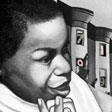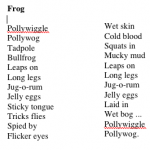 Nikki Grimes is an author of fiction and poetry who has received five Coretta Scott King Book Award recognitions. In this column she discusses her writing process. Whether it’s her focus on character development, the story behind Bronx Masquerade (Penguin, 2001), or her personal experiences that influence her research and writing, Grimes’s insights reveal the dialectical nature of writing.
Nikki Grimes is an author of fiction and poetry who has received five Coretta Scott King Book Award recognitions. In this column she discusses her writing process. Whether it’s her focus on character development, the story behind Bronx Masquerade (Penguin, 2001), or her personal experiences that influence her research and writing, Grimes’s insights reveal the dialectical nature of writing.Nikki Grimes on Writing From the Inside Out and Back Again
 Nikki Grimes is an author of fiction and poetry who has received five Coretta Scott King Book Award recognitions. In this column she discusses her writing process. Whether it’s her focus on character development, the story behind Bronx Masquerade (Penguin, 2001), or her personal experiences that influence her research and writing, Grimes’s insights reveal the dialectical nature of writing.
Nikki Grimes is an author of fiction and poetry who has received five Coretta Scott King Book Award recognitions. In this column she discusses her writing process. Whether it’s her focus on character development, the story behind Bronx Masquerade (Penguin, 2001), or her personal experiences that influence her research and writing, Grimes’s insights reveal the dialectical nature of writing.
 Twitter’s momentum as a social networking service has been extraordinary; just last December more than one billion tweets were sent. These text messages of up to 140 characters can incorporate links to Web sites, movies, audio recordings, or any address on the Internet. But how are educators harnessing this tool to support K-12 pedagogical practices? In this month’s post, sample TeachingBooks.net tweets that were posted to demonstrate to educators easy and fun ways to integrate multimedia into their author and book studies.
Twitter’s momentum as a social networking service has been extraordinary; just last December more than one billion tweets were sent. These text messages of up to 140 characters can incorporate links to Web sites, movies, audio recordings, or any address on the Internet. But how are educators harnessing this tool to support K-12 pedagogical practices? In this month’s post, sample TeachingBooks.net tweets that were posted to demonstrate to educators easy and fun ways to integrate multimedia into their author and book studies. When I was kid I used to make movies in my head. Many of them were vaguely Arthurian in tone, with a dash of Tolkien reconfigured with strong female characters who liked to read. I tried putting myself in the lead role – warrior princess or pirate queen, say, but not that often. I am, at heart, a profoundly shy person, and even an imaginary spotlight was uncomfortable.
When I was kid I used to make movies in my head. Many of them were vaguely Arthurian in tone, with a dash of Tolkien reconfigured with strong female characters who liked to read. I tried putting myself in the lead role – warrior princess or pirate queen, say, but not that often. I am, at heart, a profoundly shy person, and even an imaginary spotlight was uncomfortable. Nic Bishop is an award-winning, well-known photographer of the natural world. Having traveled all over the world to document scientists on expeditions, Bishop has his share of stories. He also goes to great pains to capture action-packed photographic images of mammals, insects, and reptiles in his own studio.
Nic Bishop is an award-winning, well-known photographer of the natural world. Having traveled all over the world to document scientists on expeditions, Bishop has his share of stories. He also goes to great pains to capture action-packed photographic images of mammals, insects, and reptiles in his own studio. Historical fiction is a complex genre. It can strive to be as absolutely accurate as the writer can make it (as I attempted in Crispin: Cross of Lead) or it may go no further than to create a general sense of time and place (as in Midnight Magic). The work that is merely dressed up in a general sense of time and place is rather like a musical comedy. There is nothing inherently wrong with this approach, and in fact there are some real advantages. The primary advantage is that one can deal with very modern ideas and simply place them where one can have the most fun.
Historical fiction is a complex genre. It can strive to be as absolutely accurate as the writer can make it (as I attempted in Crispin: Cross of Lead) or it may go no further than to create a general sense of time and place (as in Midnight Magic). The work that is merely dressed up in a general sense of time and place is rather like a musical comedy. There is nothing inherently wrong with this approach, and in fact there are some real advantages. The primary advantage is that one can deal with very modern ideas and simply place them where one can have the most fun. Powerful photographs helped change the tide of the Civil Rights Movement of the 1950s and 60s. Some of these very photos moved author Elizabeth Partridge (goddaughter of the influential photographer Dorothea Lange) when she saw them 40 years later. Consider the role that photographs, books, and interviews play in historical research as Partridge discusses her process of selecting viable sources for Marching for Freedom: Walk Together Children and Don't You Grow Weary (Penguin, 2009).
Powerful photographs helped change the tide of the Civil Rights Movement of the 1950s and 60s. Some of these very photos moved author Elizabeth Partridge (goddaughter of the influential photographer Dorothea Lange) when she saw them 40 years later. Consider the role that photographs, books, and interviews play in historical research as Partridge discusses her process of selecting viable sources for Marching for Freedom: Walk Together Children and Don't You Grow Weary (Penguin, 2009).
 Engage students with technology as you explore best practices in writing. By integrating the online resource listed in this issue into your curriculum, students can have award-winning authors model the application of specific writing tips and techniques.
Engage students with technology as you explore best practices in writing. By integrating the online resource listed in this issue into your curriculum, students can have award-winning authors model the application of specific writing tips and techniques. I went to Ghana several years ago and was overwhelmed by the beauty of the land and people, as well as the history of the place that hovered just out of reach. When I visited the slave castles, where millions of Africans were housed like cattle before being shipped as cargo and sold as slaves, I felt their spirits crying out to me. Crawling on my hands and knees through the Door of No Return, which led from the darkness of the prison to the incomprehensible vastness of a beach, I knew I must tell the story of someone who had passed that way.
I went to Ghana several years ago and was overwhelmed by the beauty of the land and people, as well as the history of the place that hovered just out of reach. When I visited the slave castles, where millions of Africans were housed like cattle before being shipped as cargo and sold as slaves, I felt their spirits crying out to me. Crawling on my hands and knees through the Door of No Return, which led from the darkness of the prison to the incomprehensible vastness of a beach, I knew I must tell the story of someone who had passed that way. Claudette Colvin, in 1955, was a 15-year-old African American girl growing up in Alabama. She refused to surrender her seat to a white passenger on a segregated bus in Montgomery, Alabama a full nine months before Rosa Parks later became famous by doing the same thing.
Claudette Colvin, in 1955, was a 15-year-old African American girl growing up in Alabama. She refused to surrender her seat to a white passenger on a segregated bus in Montgomery, Alabama a full nine months before Rosa Parks later became famous by doing the same thing.
 As a way to perpetuate readers' personal connections with book creators, we at TeachingBooks.net have periodically featured original artwork created by some of the illustrators with whom we've worked.
As a way to perpetuate readers' personal connections with book creators, we at TeachingBooks.net have periodically featured original artwork created by some of the illustrators with whom we've worked. While the pressures in education today are very real, the joy, passion, and commitment that teachers bring to the profession can assist them when the challenges are great. This month’s column highlights online resources that are sure to bring a little levity to the classroom and elicit a few smiles and laughs.
While the pressures in education today are very real, the joy, passion, and commitment that teachers bring to the profession can assist them when the challenges are great. This month’s column highlights online resources that are sure to bring a little levity to the classroom and elicit a few smiles and laughs.
 Why memorize poetry? For the sheer joy of it! If there is a poem you love, nothing is more satisfying than committing it to memory. You’ll get to know the work far more deeply when you have read it aloud a number of times and familiarized yourself with its rhymes, rhythms, and repetitions as part of a living composition.
Why memorize poetry? For the sheer joy of it! If there is a poem you love, nothing is more satisfying than committing it to memory. You’ll get to know the work far more deeply when you have read it aloud a number of times and familiarized yourself with its rhymes, rhythms, and repetitions as part of a living composition.